Analyzing General Mills' Financial Statements and Performance
VerifiedAdded on 2023/06/03
|9
|2235
|134
Homework Assignment
AI Summary
This assignment presents a detailed financial analysis of General Mills, examining its consolidated financial statements, including the income statement, balance sheet, and statement of cash flows. The analysis covers the company's segments, revenue recognition practices, and key financial metrics. It includes common size statements for comparative analysis and evaluates the company's profitability, liquidity, and solvency. The analysis also explores the accounting equation, major assets and liabilities, intangible assets (like goodwill), and financing sources. Furthermore, it delves into the company's revenue recognition policies, major expenses, and the impact of restructuring and other costs. The assignment also covers the statement of cash flows, including cash generated from operations and significant expenditures. Finally, it identifies accounts that require estimates in financial reporting.
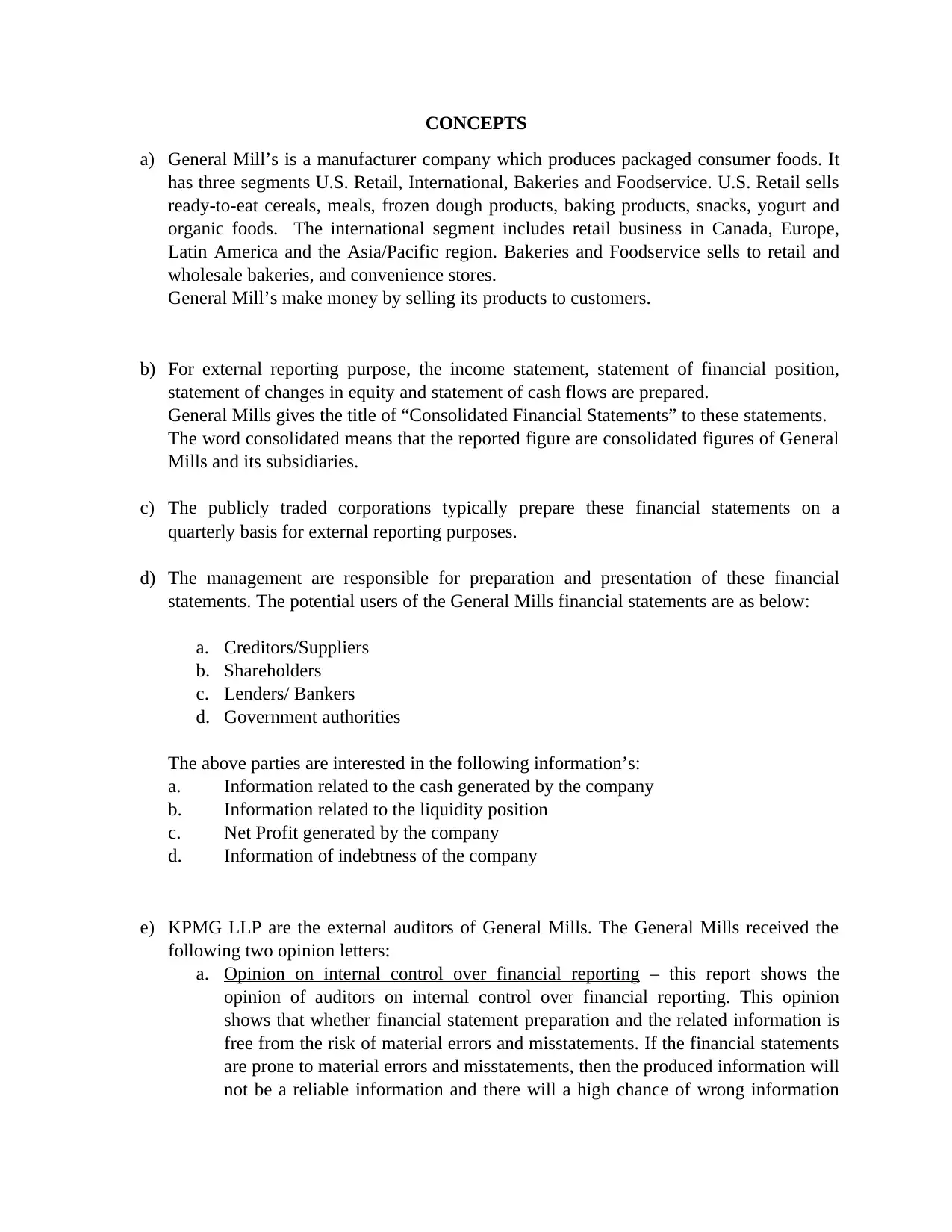
CONCEPTS
a) General Mill’s is a manufacturer company which produces packaged consumer foods. It
has three segments U.S. Retail, International, Bakeries and Foodservice. U.S. Retail sells
ready-to-eat cereals, meals, frozen dough products, baking products, snacks, yogurt and
organic foods. The international segment includes retail business in Canada, Europe,
Latin America and the Asia/Pacific region. Bakeries and Foodservice sells to retail and
wholesale bakeries, and convenience stores.
General Mill’s make money by selling its products to customers.
b) For external reporting purpose, the income statement, statement of financial position,
statement of changes in equity and statement of cash flows are prepared.
General Mills gives the title of “Consolidated Financial Statements” to these statements.
The word consolidated means that the reported figure are consolidated figures of General
Mills and its subsidiaries.
c) The publicly traded corporations typically prepare these financial statements on a
quarterly basis for external reporting purposes.
d) The management are responsible for preparation and presentation of these financial
statements. The potential users of the General Mills financial statements are as below:
a. Creditors/Suppliers
b. Shareholders
c. Lenders/ Bankers
d. Government authorities
The above parties are interested in the following information’s:
a. Information related to the cash generated by the company
b. Information related to the liquidity position
c. Net Profit generated by the company
d. Information of indebtness of the company
e) KPMG LLP are the external auditors of General Mills. The General Mills received the
following two opinion letters:
a. Opinion on internal control over financial reporting – this report shows the
opinion of auditors on internal control over financial reporting. This opinion
shows that whether financial statement preparation and the related information is
free from the risk of material errors and misstatements. If the financial statements
are prone to material errors and misstatements, then the produced information will
not be a reliable information and there will a high chance of wrong information
a) General Mill’s is a manufacturer company which produces packaged consumer foods. It
has three segments U.S. Retail, International, Bakeries and Foodservice. U.S. Retail sells
ready-to-eat cereals, meals, frozen dough products, baking products, snacks, yogurt and
organic foods. The international segment includes retail business in Canada, Europe,
Latin America and the Asia/Pacific region. Bakeries and Foodservice sells to retail and
wholesale bakeries, and convenience stores.
General Mill’s make money by selling its products to customers.
b) For external reporting purpose, the income statement, statement of financial position,
statement of changes in equity and statement of cash flows are prepared.
General Mills gives the title of “Consolidated Financial Statements” to these statements.
The word consolidated means that the reported figure are consolidated figures of General
Mills and its subsidiaries.
c) The publicly traded corporations typically prepare these financial statements on a
quarterly basis for external reporting purposes.
d) The management are responsible for preparation and presentation of these financial
statements. The potential users of the General Mills financial statements are as below:
a. Creditors/Suppliers
b. Shareholders
c. Lenders/ Bankers
d. Government authorities
The above parties are interested in the following information’s:
a. Information related to the cash generated by the company
b. Information related to the liquidity position
c. Net Profit generated by the company
d. Information of indebtness of the company
e) KPMG LLP are the external auditors of General Mills. The General Mills received the
following two opinion letters:
a. Opinion on internal control over financial reporting – this report shows the
opinion of auditors on internal control over financial reporting. This opinion
shows that whether financial statement preparation and the related information is
free from the risk of material errors and misstatements. If the financial statements
are prone to material errors and misstatements, then the produced information will
not be a reliable information and there will a high chance of wrong information
Paraphrase This Document
Need a fresh take? Get an instant paraphrase of this document with our AI Paraphraser
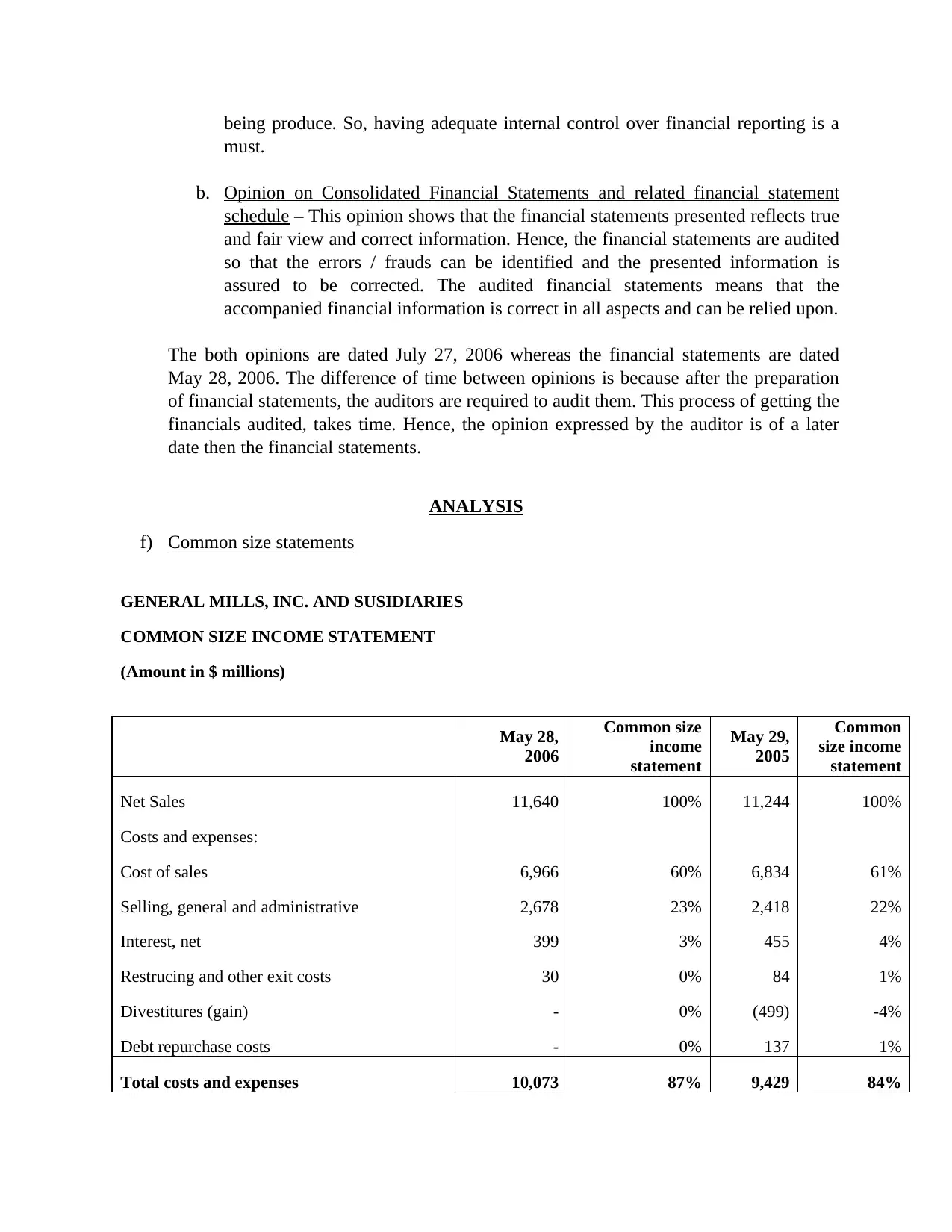
being produce. So, having adequate internal control over financial reporting is a
must.
b. Opinion on Consolidated Financial Statements and related financial statement
schedule – This opinion shows that the financial statements presented reflects true
and fair view and correct information. Hence, the financial statements are audited
so that the errors / frauds can be identified and the presented information is
assured to be corrected. The audited financial statements means that the
accompanied financial information is correct in all aspects and can be relied upon.
The both opinions are dated July 27, 2006 whereas the financial statements are dated
May 28, 2006. The difference of time between opinions is because after the preparation
of financial statements, the auditors are required to audit them. This process of getting the
financials audited, takes time. Hence, the opinion expressed by the auditor is of a later
date then the financial statements.
ANALYSIS
f) Common size statements
GENERAL MILLS, INC. AND SUSIDIARIES
COMMON SIZE INCOME STATEMENT
(Amount in $ millions)
May 28,
2006
Common size
income
statement
May 29,
2005
Common
size income
statement
Net Sales 11,640 100% 11,244 100%
Costs and expenses:
Cost of sales 6,966 60% 6,834 61%
Selling, general and administrative 2,678 23% 2,418 22%
Interest, net 399 3% 455 4%
Restrucing and other exit costs 30 0% 84 1%
Divestitures (gain) - 0% (499) -4%
Debt repurchase costs - 0% 137 1%
Total costs and expenses 10,073 87% 9,429 84%
must.
b. Opinion on Consolidated Financial Statements and related financial statement
schedule – This opinion shows that the financial statements presented reflects true
and fair view and correct information. Hence, the financial statements are audited
so that the errors / frauds can be identified and the presented information is
assured to be corrected. The audited financial statements means that the
accompanied financial information is correct in all aspects and can be relied upon.
The both opinions are dated July 27, 2006 whereas the financial statements are dated
May 28, 2006. The difference of time between opinions is because after the preparation
of financial statements, the auditors are required to audit them. This process of getting the
financials audited, takes time. Hence, the opinion expressed by the auditor is of a later
date then the financial statements.
ANALYSIS
f) Common size statements
GENERAL MILLS, INC. AND SUSIDIARIES
COMMON SIZE INCOME STATEMENT
(Amount in $ millions)
May 28,
2006
Common size
income
statement
May 29,
2005
Common
size income
statement
Net Sales 11,640 100% 11,244 100%
Costs and expenses:
Cost of sales 6,966 60% 6,834 61%
Selling, general and administrative 2,678 23% 2,418 22%
Interest, net 399 3% 455 4%
Restrucing and other exit costs 30 0% 84 1%
Divestitures (gain) - 0% (499) -4%
Debt repurchase costs - 0% 137 1%
Total costs and expenses 10,073 87% 9,429 84%
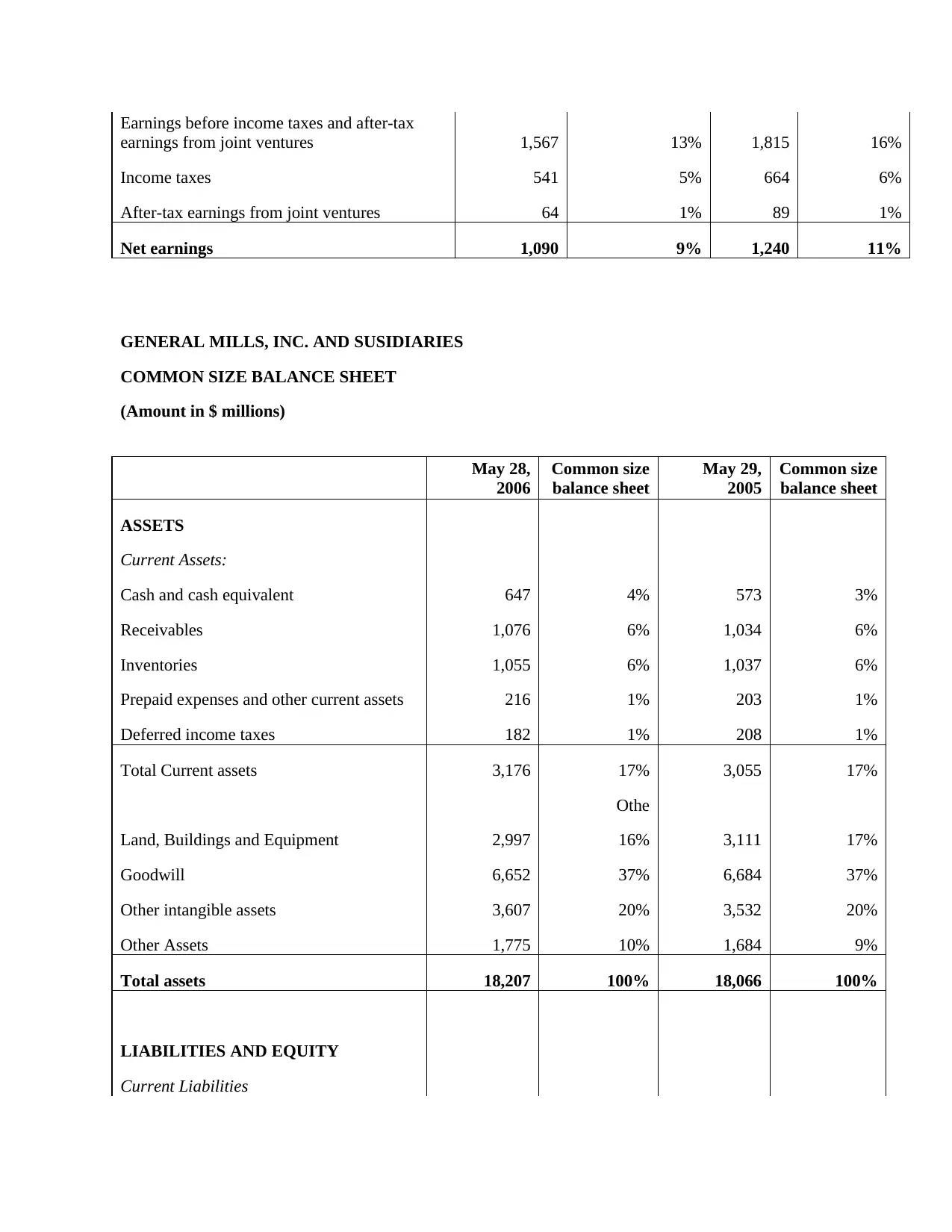
Earnings before income taxes and after-tax
earnings from joint ventures 1,567 13% 1,815 16%
Income taxes 541 5% 664 6%
After-tax earnings from joint ventures 64 1% 89 1%
Net earnings 1,090 9% 1,240 11%
GENERAL MILLS, INC. AND SUSIDIARIES
COMMON SIZE BALANCE SHEET
(Amount in $ millions)
May 28,
2006
Common size
balance sheet
May 29,
2005
Common size
balance sheet
ASSETS
Current Assets:
Cash and cash equivalent 647 4% 573 3%
Receivables 1,076 6% 1,034 6%
Inventories 1,055 6% 1,037 6%
Prepaid expenses and other current assets 216 1% 203 1%
Deferred income taxes 182 1% 208 1%
Total Current assets 3,176 17% 3,055 17%
Othe
Land, Buildings and Equipment 2,997 16% 3,111 17%
Goodwill 6,652 37% 6,684 37%
Other intangible assets 3,607 20% 3,532 20%
Other Assets 1,775 10% 1,684 9%
Total assets 18,207 100% 18,066 100%
LIABILITIES AND EQUITY
Current Liabilities
earnings from joint ventures 1,567 13% 1,815 16%
Income taxes 541 5% 664 6%
After-tax earnings from joint ventures 64 1% 89 1%
Net earnings 1,090 9% 1,240 11%
GENERAL MILLS, INC. AND SUSIDIARIES
COMMON SIZE BALANCE SHEET
(Amount in $ millions)
May 28,
2006
Common size
balance sheet
May 29,
2005
Common size
balance sheet
ASSETS
Current Assets:
Cash and cash equivalent 647 4% 573 3%
Receivables 1,076 6% 1,034 6%
Inventories 1,055 6% 1,037 6%
Prepaid expenses and other current assets 216 1% 203 1%
Deferred income taxes 182 1% 208 1%
Total Current assets 3,176 17% 3,055 17%
Othe
Land, Buildings and Equipment 2,997 16% 3,111 17%
Goodwill 6,652 37% 6,684 37%
Other intangible assets 3,607 20% 3,532 20%
Other Assets 1,775 10% 1,684 9%
Total assets 18,207 100% 18,066 100%
LIABILITIES AND EQUITY
Current Liabilities
⊘ This is a preview!⊘
Do you want full access?
Subscribe today to unlock all pages.

Trusted by 1+ million students worldwide
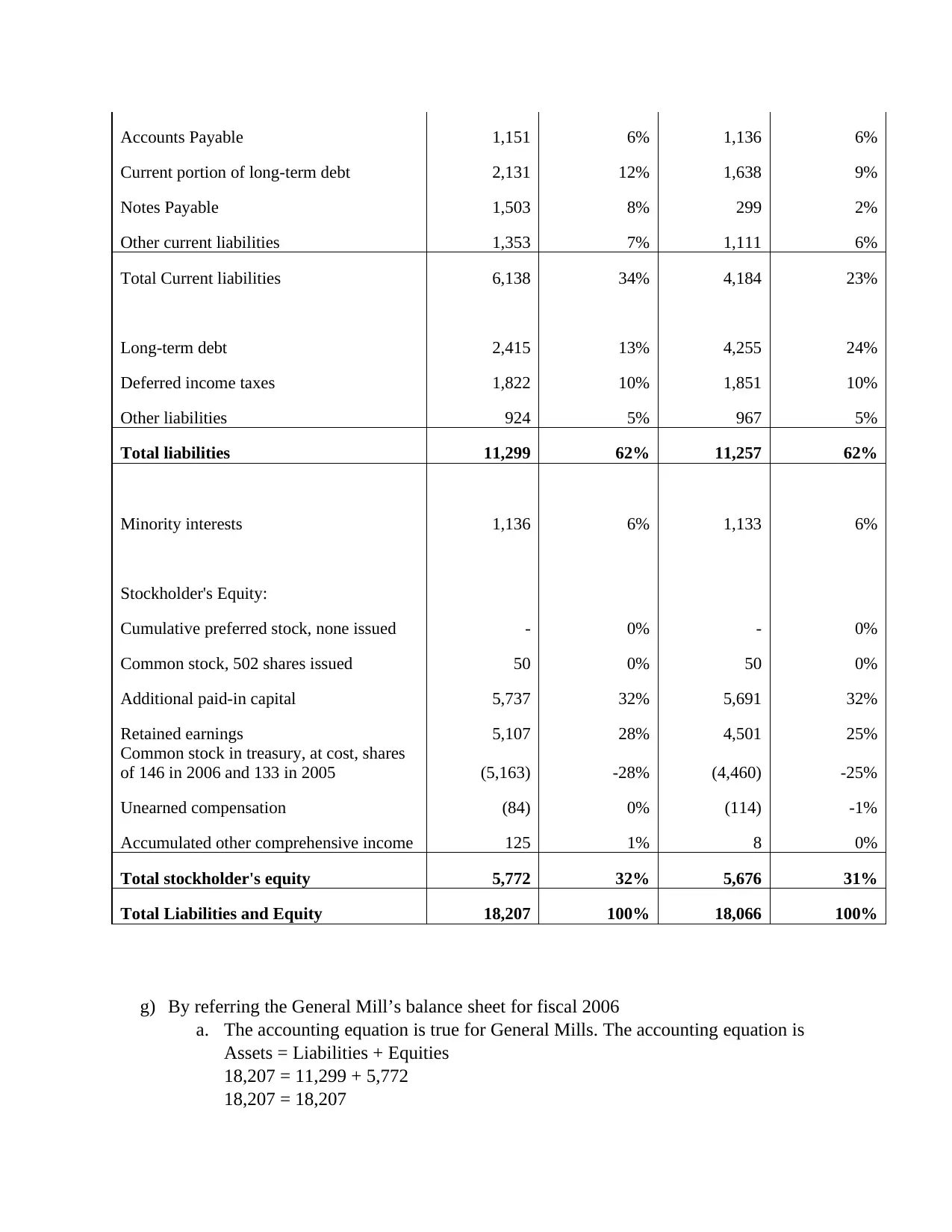
Accounts Payable 1,151 6% 1,136 6%
Current portion of long-term debt 2,131 12% 1,638 9%
Notes Payable 1,503 8% 299 2%
Other current liabilities 1,353 7% 1,111 6%
Total Current liabilities 6,138 34% 4,184 23%
Long-term debt 2,415 13% 4,255 24%
Deferred income taxes 1,822 10% 1,851 10%
Other liabilities 924 5% 967 5%
Total liabilities 11,299 62% 11,257 62%
Minority interests 1,136 6% 1,133 6%
Stockholder's Equity:
Cumulative preferred stock, none issued - 0% - 0%
Common stock, 502 shares issued 50 0% 50 0%
Additional paid-in capital 5,737 32% 5,691 32%
Retained earnings 5,107 28% 4,501 25%
Common stock in treasury, at cost, shares
of 146 in 2006 and 133 in 2005 (5,163) -28% (4,460) -25%
Unearned compensation (84) 0% (114) -1%
Accumulated other comprehensive income 125 1% 8 0%
Total stockholder's equity 5,772 32% 5,676 31%
Total Liabilities and Equity 18,207 100% 18,066 100%
g) By referring the General Mill’s balance sheet for fiscal 2006
a. The accounting equation is true for General Mills. The accounting equation is
Assets = Liabilities + Equities
18,207 = 11,299 + 5,772
18,207 = 18,207
Current portion of long-term debt 2,131 12% 1,638 9%
Notes Payable 1,503 8% 299 2%
Other current liabilities 1,353 7% 1,111 6%
Total Current liabilities 6,138 34% 4,184 23%
Long-term debt 2,415 13% 4,255 24%
Deferred income taxes 1,822 10% 1,851 10%
Other liabilities 924 5% 967 5%
Total liabilities 11,299 62% 11,257 62%
Minority interests 1,136 6% 1,133 6%
Stockholder's Equity:
Cumulative preferred stock, none issued - 0% - 0%
Common stock, 502 shares issued 50 0% 50 0%
Additional paid-in capital 5,737 32% 5,691 32%
Retained earnings 5,107 28% 4,501 25%
Common stock in treasury, at cost, shares
of 146 in 2006 and 133 in 2005 (5,163) -28% (4,460) -25%
Unearned compensation (84) 0% (114) -1%
Accumulated other comprehensive income 125 1% 8 0%
Total stockholder's equity 5,772 32% 5,676 31%
Total Liabilities and Equity 18,207 100% 18,066 100%
g) By referring the General Mill’s balance sheet for fiscal 2006
a. The accounting equation is true for General Mills. The accounting equation is
Assets = Liabilities + Equities
18,207 = 11,299 + 5,772
18,207 = 18,207
Paraphrase This Document
Need a fresh take? Get an instant paraphrase of this document with our AI Paraphraser
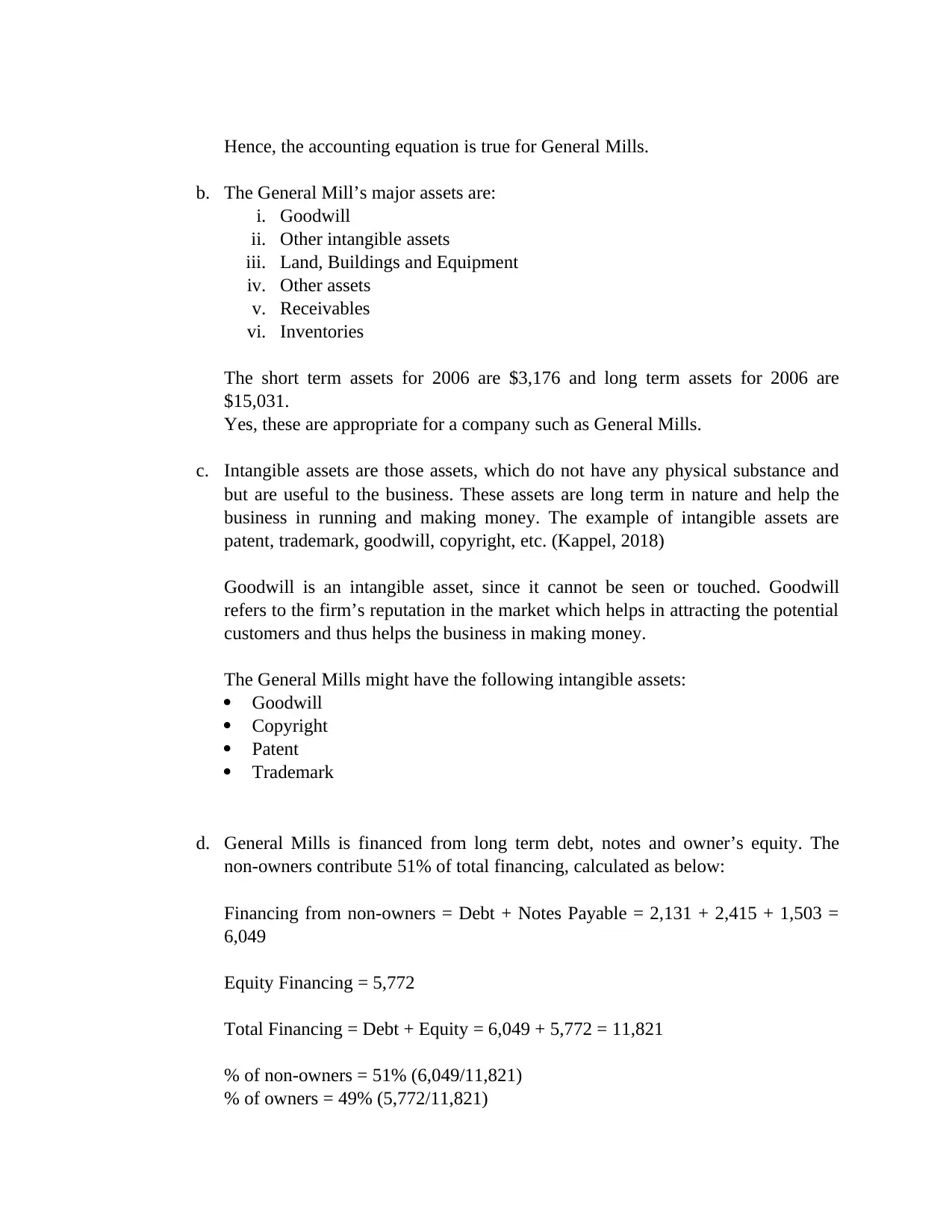
Hence, the accounting equation is true for General Mills.
b. The General Mill’s major assets are:
i. Goodwill
ii. Other intangible assets
iii. Land, Buildings and Equipment
iv. Other assets
v. Receivables
vi. Inventories
The short term assets for 2006 are $3,176 and long term assets for 2006 are
$15,031.
Yes, these are appropriate for a company such as General Mills.
c. Intangible assets are those assets, which do not have any physical substance and
but are useful to the business. These assets are long term in nature and help the
business in running and making money. The example of intangible assets are
patent, trademark, goodwill, copyright, etc. (Kappel, 2018)
Goodwill is an intangible asset, since it cannot be seen or touched. Goodwill
refers to the firm’s reputation in the market which helps in attracting the potential
customers and thus helps the business in making money.
The General Mills might have the following intangible assets:
Goodwill
Copyright
Patent
Trademark
d. General Mills is financed from long term debt, notes and owner’s equity. The
non-owners contribute 51% of total financing, calculated as below:
Financing from non-owners = Debt + Notes Payable = 2,131 + 2,415 + 1,503 =
6,049
Equity Financing = 5,772
Total Financing = Debt + Equity = 6,049 + 5,772 = 11,821
% of non-owners = 51% (6,049/11,821)
% of owners = 49% (5,772/11,821)
b. The General Mill’s major assets are:
i. Goodwill
ii. Other intangible assets
iii. Land, Buildings and Equipment
iv. Other assets
v. Receivables
vi. Inventories
The short term assets for 2006 are $3,176 and long term assets for 2006 are
$15,031.
Yes, these are appropriate for a company such as General Mills.
c. Intangible assets are those assets, which do not have any physical substance and
but are useful to the business. These assets are long term in nature and help the
business in running and making money. The example of intangible assets are
patent, trademark, goodwill, copyright, etc. (Kappel, 2018)
Goodwill is an intangible asset, since it cannot be seen or touched. Goodwill
refers to the firm’s reputation in the market which helps in attracting the potential
customers and thus helps the business in making money.
The General Mills might have the following intangible assets:
Goodwill
Copyright
Patent
Trademark
d. General Mills is financed from long term debt, notes and owner’s equity. The
non-owners contribute 51% of total financing, calculated as below:
Financing from non-owners = Debt + Notes Payable = 2,131 + 2,415 + 1,503 =
6,049
Equity Financing = 5,772
Total Financing = Debt + Equity = 6,049 + 5,772 = 11,821
% of non-owners = 51% (6,049/11,821)
% of owners = 49% (5,772/11,821)
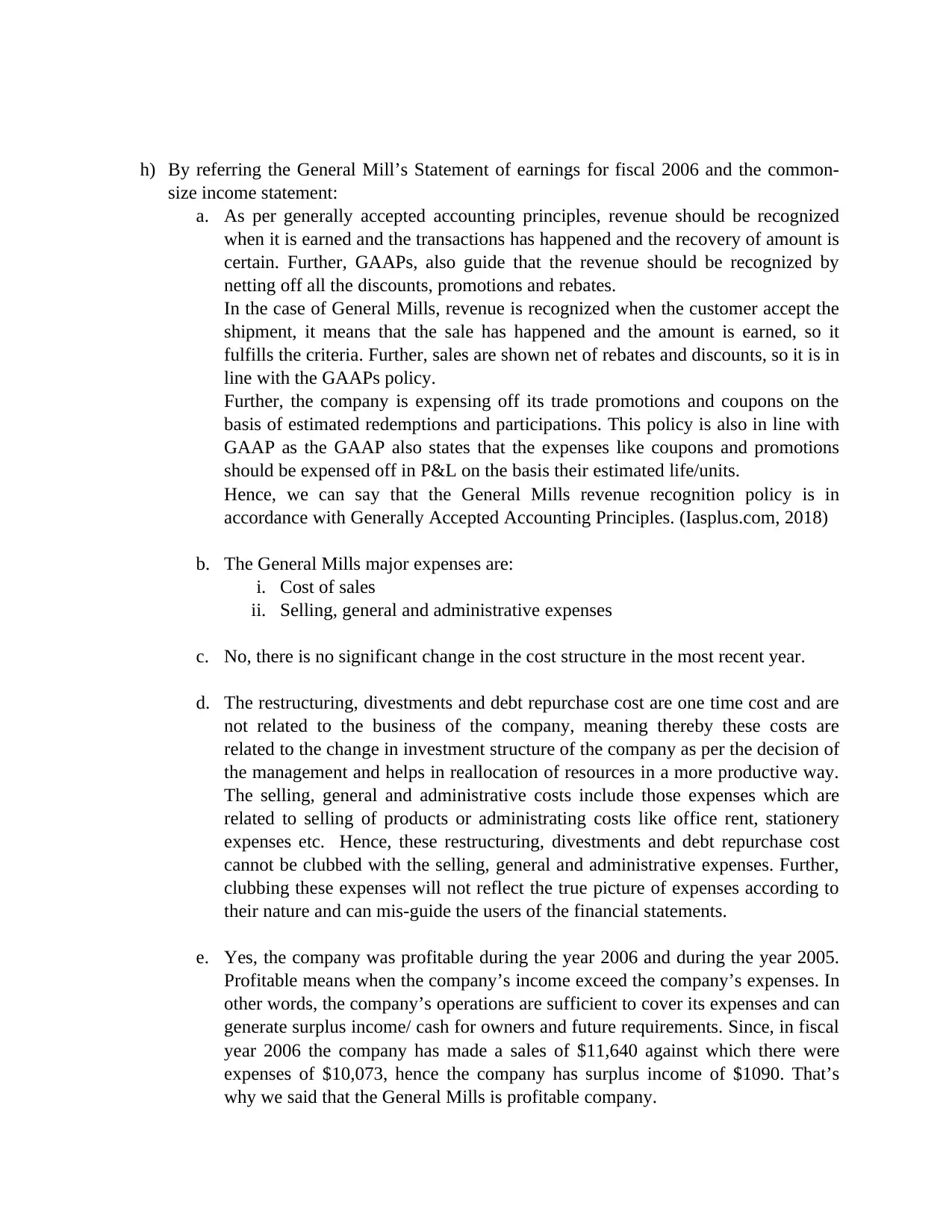
h) By referring the General Mill’s Statement of earnings for fiscal 2006 and the common-
size income statement:
a. As per generally accepted accounting principles, revenue should be recognized
when it is earned and the transactions has happened and the recovery of amount is
certain. Further, GAAPs, also guide that the revenue should be recognized by
netting off all the discounts, promotions and rebates.
In the case of General Mills, revenue is recognized when the customer accept the
shipment, it means that the sale has happened and the amount is earned, so it
fulfills the criteria. Further, sales are shown net of rebates and discounts, so it is in
line with the GAAPs policy.
Further, the company is expensing off its trade promotions and coupons on the
basis of estimated redemptions and participations. This policy is also in line with
GAAP as the GAAP also states that the expenses like coupons and promotions
should be expensed off in P&L on the basis their estimated life/units.
Hence, we can say that the General Mills revenue recognition policy is in
accordance with Generally Accepted Accounting Principles. (Iasplus.com, 2018)
b. The General Mills major expenses are:
i. Cost of sales
ii. Selling, general and administrative expenses
c. No, there is no significant change in the cost structure in the most recent year.
d. The restructuring, divestments and debt repurchase cost are one time cost and are
not related to the business of the company, meaning thereby these costs are
related to the change in investment structure of the company as per the decision of
the management and helps in reallocation of resources in a more productive way.
The selling, general and administrative costs include those expenses which are
related to selling of products or administrating costs like office rent, stationery
expenses etc. Hence, these restructuring, divestments and debt repurchase cost
cannot be clubbed with the selling, general and administrative expenses. Further,
clubbing these expenses will not reflect the true picture of expenses according to
their nature and can mis-guide the users of the financial statements.
e. Yes, the company was profitable during the year 2006 and during the year 2005.
Profitable means when the company’s income exceed the company’s expenses. In
other words, the company’s operations are sufficient to cover its expenses and can
generate surplus income/ cash for owners and future requirements. Since, in fiscal
year 2006 the company has made a sales of $11,640 against which there were
expenses of $10,073, hence the company has surplus income of $1090. That’s
why we said that the General Mills is profitable company.
size income statement:
a. As per generally accepted accounting principles, revenue should be recognized
when it is earned and the transactions has happened and the recovery of amount is
certain. Further, GAAPs, also guide that the revenue should be recognized by
netting off all the discounts, promotions and rebates.
In the case of General Mills, revenue is recognized when the customer accept the
shipment, it means that the sale has happened and the amount is earned, so it
fulfills the criteria. Further, sales are shown net of rebates and discounts, so it is in
line with the GAAPs policy.
Further, the company is expensing off its trade promotions and coupons on the
basis of estimated redemptions and participations. This policy is also in line with
GAAP as the GAAP also states that the expenses like coupons and promotions
should be expensed off in P&L on the basis their estimated life/units.
Hence, we can say that the General Mills revenue recognition policy is in
accordance with Generally Accepted Accounting Principles. (Iasplus.com, 2018)
b. The General Mills major expenses are:
i. Cost of sales
ii. Selling, general and administrative expenses
c. No, there is no significant change in the cost structure in the most recent year.
d. The restructuring, divestments and debt repurchase cost are one time cost and are
not related to the business of the company, meaning thereby these costs are
related to the change in investment structure of the company as per the decision of
the management and helps in reallocation of resources in a more productive way.
The selling, general and administrative costs include those expenses which are
related to selling of products or administrating costs like office rent, stationery
expenses etc. Hence, these restructuring, divestments and debt repurchase cost
cannot be clubbed with the selling, general and administrative expenses. Further,
clubbing these expenses will not reflect the true picture of expenses according to
their nature and can mis-guide the users of the financial statements.
e. Yes, the company was profitable during the year 2006 and during the year 2005.
Profitable means when the company’s income exceed the company’s expenses. In
other words, the company’s operations are sufficient to cover its expenses and can
generate surplus income/ cash for owners and future requirements. Since, in fiscal
year 2006 the company has made a sales of $11,640 against which there were
expenses of $10,073, hence the company has surplus income of $1090. That’s
why we said that the General Mills is profitable company.
⊘ This is a preview!⊘
Do you want full access?
Subscribe today to unlock all pages.

Trusted by 1+ million students worldwide
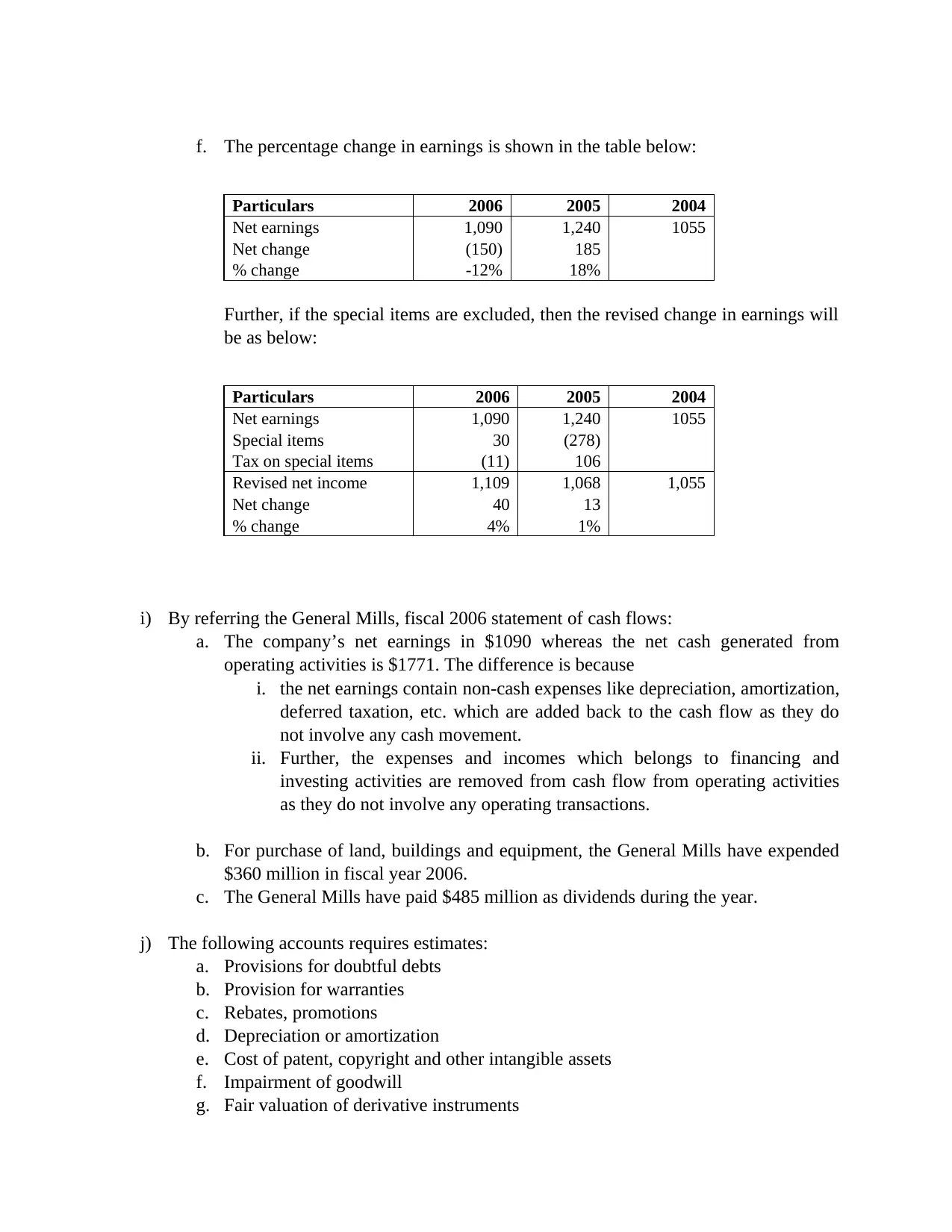
f. The percentage change in earnings is shown in the table below:
Particulars 2006 2005 2004
Net earnings 1,090 1,240 1055
Net change (150) 185
% change -12% 18%
Further, if the special items are excluded, then the revised change in earnings will
be as below:
Particulars 2006 2005 2004
Net earnings 1,090 1,240 1055
Special items 30 (278)
Tax on special items (11) 106
Revised net income 1,109 1,068 1,055
Net change 40 13
% change 4% 1%
i) By referring the General Mills, fiscal 2006 statement of cash flows:
a. The company’s net earnings in $1090 whereas the net cash generated from
operating activities is $1771. The difference is because
i. the net earnings contain non-cash expenses like depreciation, amortization,
deferred taxation, etc. which are added back to the cash flow as they do
not involve any cash movement.
ii. Further, the expenses and incomes which belongs to financing and
investing activities are removed from cash flow from operating activities
as they do not involve any operating transactions.
b. For purchase of land, buildings and equipment, the General Mills have expended
$360 million in fiscal year 2006.
c. The General Mills have paid $485 million as dividends during the year.
j) The following accounts requires estimates:
a. Provisions for doubtful debts
b. Provision for warranties
c. Rebates, promotions
d. Depreciation or amortization
e. Cost of patent, copyright and other intangible assets
f. Impairment of goodwill
g. Fair valuation of derivative instruments
Particulars 2006 2005 2004
Net earnings 1,090 1,240 1055
Net change (150) 185
% change -12% 18%
Further, if the special items are excluded, then the revised change in earnings will
be as below:
Particulars 2006 2005 2004
Net earnings 1,090 1,240 1055
Special items 30 (278)
Tax on special items (11) 106
Revised net income 1,109 1,068 1,055
Net change 40 13
% change 4% 1%
i) By referring the General Mills, fiscal 2006 statement of cash flows:
a. The company’s net earnings in $1090 whereas the net cash generated from
operating activities is $1771. The difference is because
i. the net earnings contain non-cash expenses like depreciation, amortization,
deferred taxation, etc. which are added back to the cash flow as they do
not involve any cash movement.
ii. Further, the expenses and incomes which belongs to financing and
investing activities are removed from cash flow from operating activities
as they do not involve any operating transactions.
b. For purchase of land, buildings and equipment, the General Mills have expended
$360 million in fiscal year 2006.
c. The General Mills have paid $485 million as dividends during the year.
j) The following accounts requires estimates:
a. Provisions for doubtful debts
b. Provision for warranties
c. Rebates, promotions
d. Depreciation or amortization
e. Cost of patent, copyright and other intangible assets
f. Impairment of goodwill
g. Fair valuation of derivative instruments
Paraphrase This Document
Need a fresh take? Get an instant paraphrase of this document with our AI Paraphraser

h. Cost of compensation
Yes, the accounts such as sales, taxes, purchases, cost of fixed assets, cost of liabilities,
etc. are estimate free.
Yes, the accounts such as sales, taxes, purchases, cost of fixed assets, cost of liabilities,
etc. are estimate free.
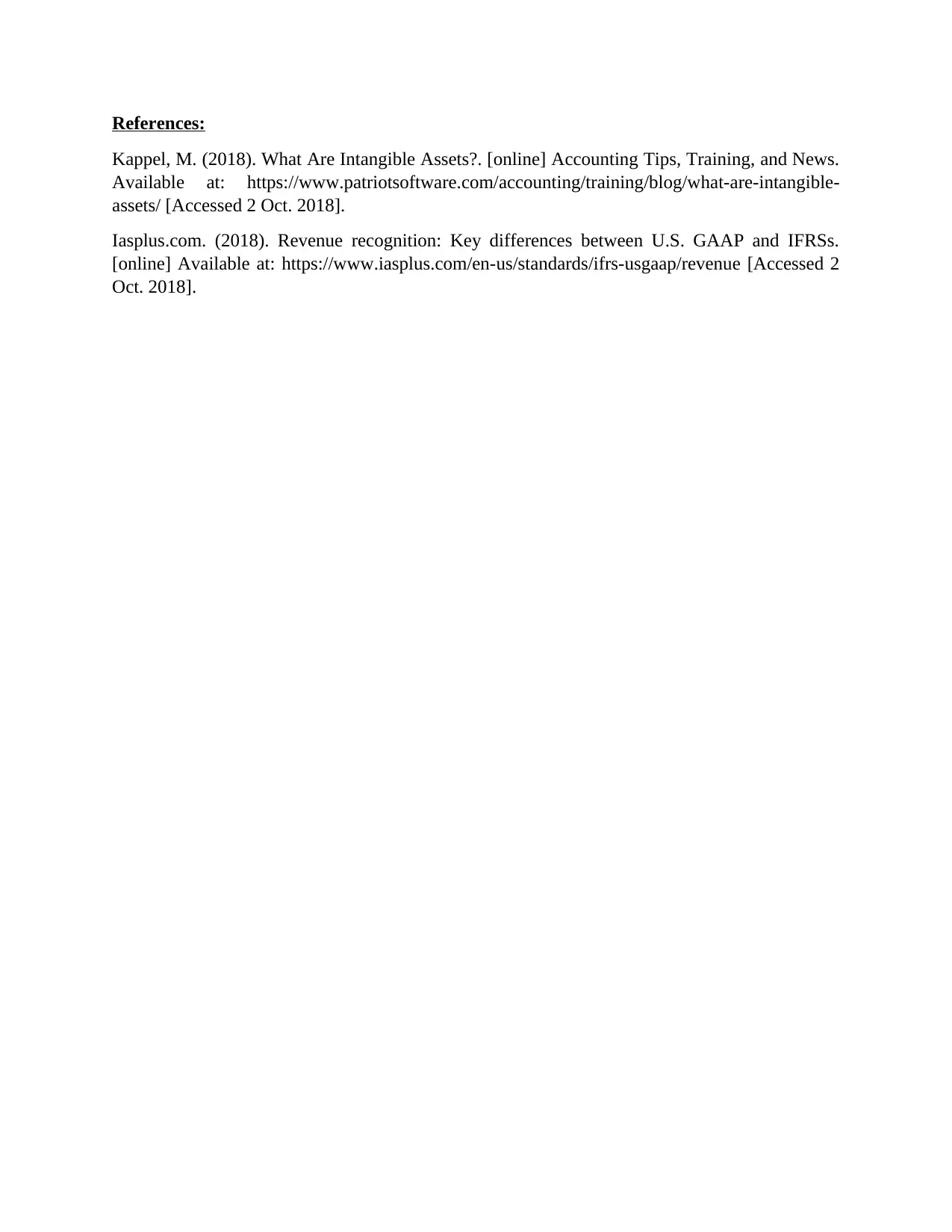
References:
Kappel, M. (2018). What Are Intangible Assets?. [online] Accounting Tips, Training, and News.
Available at: https://www.patriotsoftware.com/accounting/training/blog/what-are-intangible-
assets/ [Accessed 2 Oct. 2018].
Iasplus.com. (2018). Revenue recognition: Key differences between U.S. GAAP and IFRSs.
[online] Available at: https://www.iasplus.com/en-us/standards/ifrs-usgaap/revenue [Accessed 2
Oct. 2018].
Kappel, M. (2018). What Are Intangible Assets?. [online] Accounting Tips, Training, and News.
Available at: https://www.patriotsoftware.com/accounting/training/blog/what-are-intangible-
assets/ [Accessed 2 Oct. 2018].
Iasplus.com. (2018). Revenue recognition: Key differences between U.S. GAAP and IFRSs.
[online] Available at: https://www.iasplus.com/en-us/standards/ifrs-usgaap/revenue [Accessed 2
Oct. 2018].
⊘ This is a preview!⊘
Do you want full access?
Subscribe today to unlock all pages.

Trusted by 1+ million students worldwide
1 out of 9
Related Documents
Your All-in-One AI-Powered Toolkit for Academic Success.
+13062052269
info@desklib.com
Available 24*7 on WhatsApp / Email
![[object Object]](/_next/static/media/star-bottom.7253800d.svg)
Unlock your academic potential
Copyright © 2020–2025 A2Z Services. All Rights Reserved. Developed and managed by ZUCOL.





